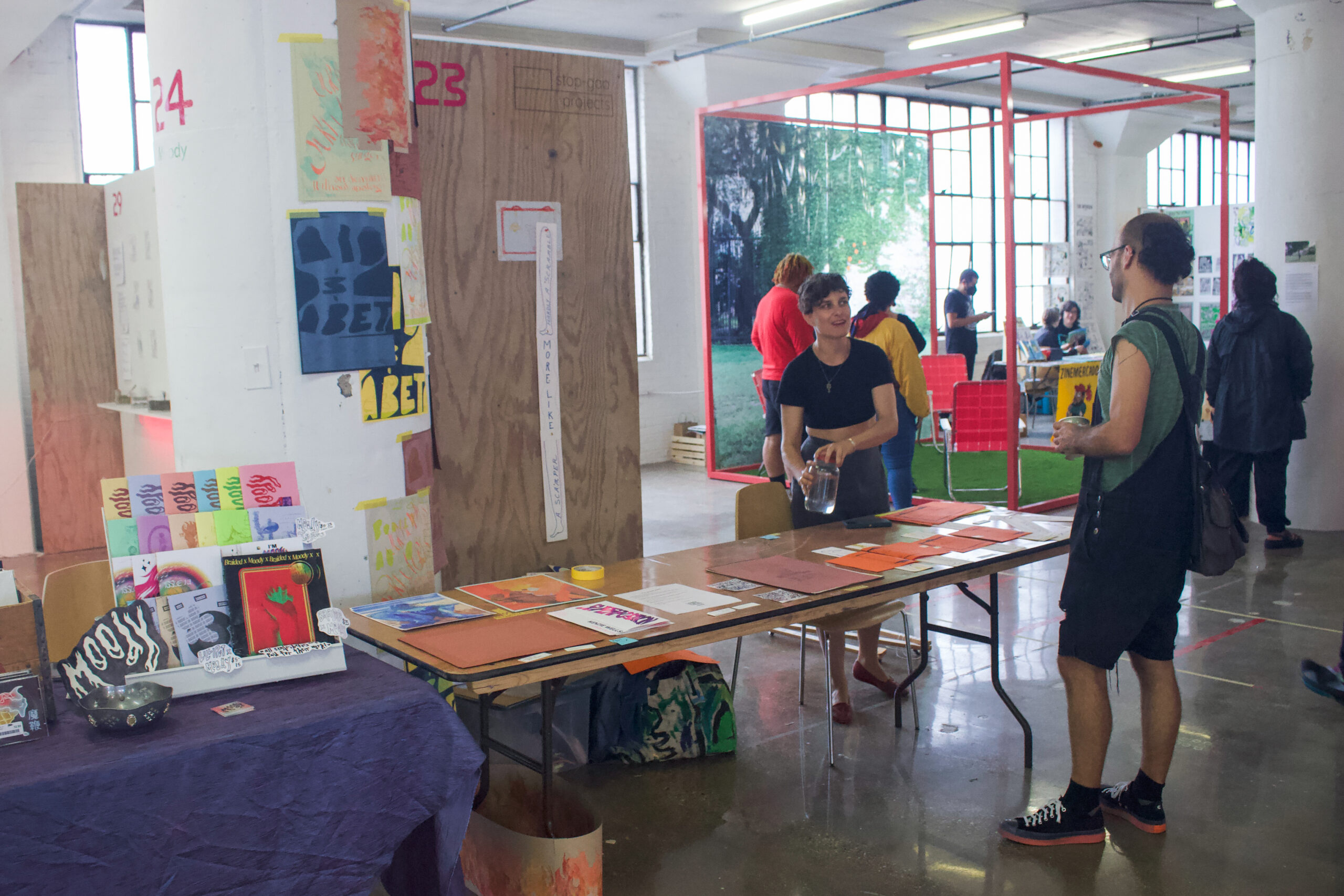Exuberant and teeming with good ideas, artists and cultural producers Brandon Alvendia and Nicholas Wylie are kindred spirits. The two are co-conspirators in producing MdW (pronounced “Midway”), along with a dedicated team at Public Media Institute in Chicago, and bolstered by a collective of artist organizers in seven Midwestern states.
Both Alvendia and Wylie have brilliant minds; their wealth of experiences ranges from managing artist residency programs and artist-run spaces in Chicago to publishing initiatives, exhibitions, and everything in between. Armed with these myriad experiences, the pair was well-equipped to handle nearly any situation such as inaccurate wall dimensions, an unexpected power outage, or mobilizing hundreds of people for a shared meal.
Aside from these logistical details, both of them work in an artist-centered way, where the needs of artists are of utmost importance and this generosity is evident in their work.
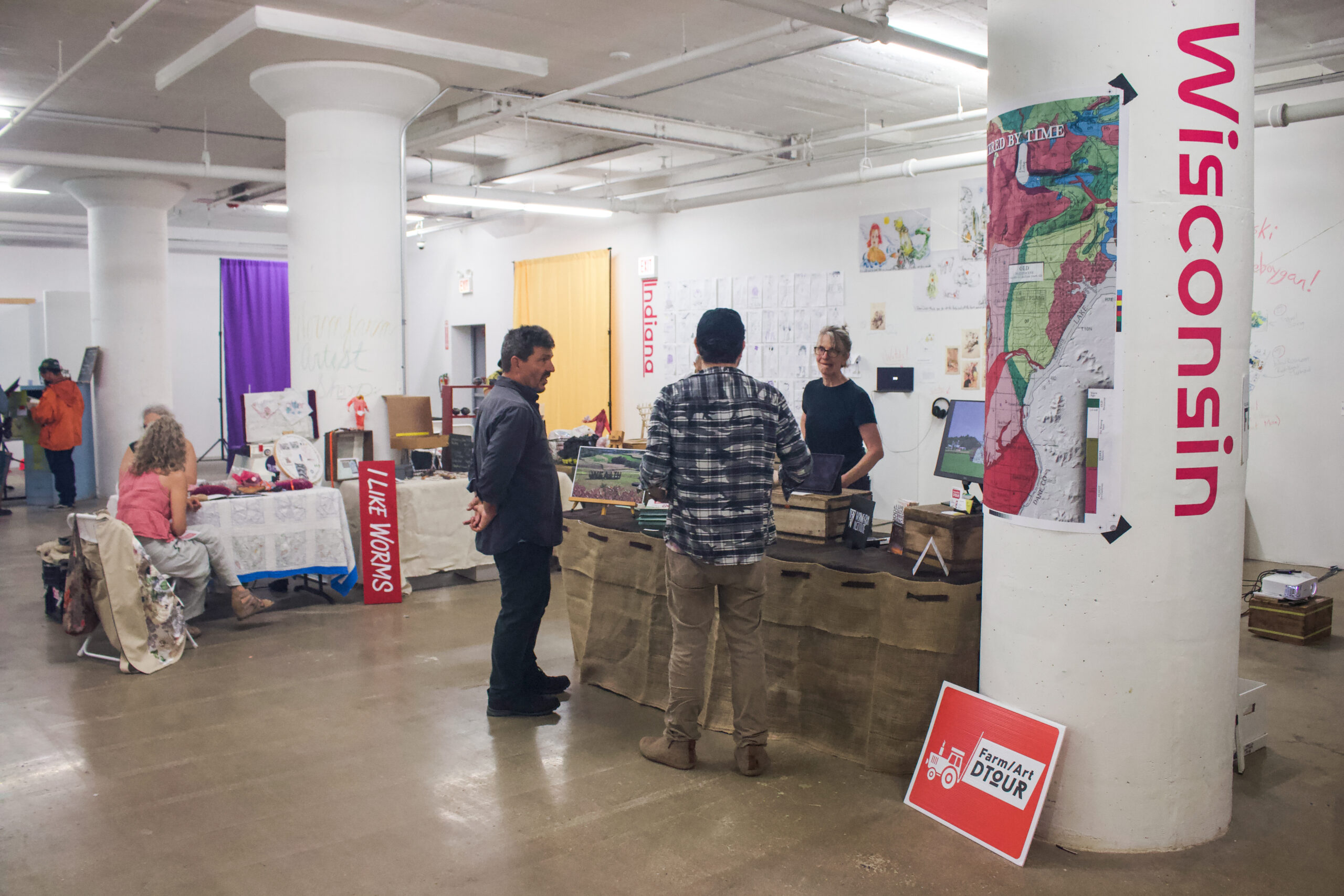
How would one organize an artist assembly covering seven Midwestern states? The first iteration of MdW in 2012 consisted primarily of Chicago’s artist-run spaces with a handful of other spaces represented. In the initial planning for the 2022 MdW iteration, Alvendia and Wylie conceived of a broader geographic footprint: all the central Midwestern states touching Illinois. This consortium would include Illinois (Public Media Institute), Indiana (Big Car Collaborative), Iowa (Public Space One), Michigan (BULK Space), Minnesota (Confluence Studio), Missouri (Charlotte Street), and Wisconsin (Wormfarm Institute).
The larger research inquiry of connectivity across the Midwest, in regard to artist-run spaces, developed from Alvendia’s curatorial research from 2015 to the present. Through the support of an Independent Curators International (ICI) Research Fellowship, he was embarking on short road trips in the region to explore and learn from artist-run spaces and other DIY initiatives “along the Mississippi River and its tributaries, mapping an archipelago of art worlds in the middle of the United States.”
Alvendia’s extensive mapping of these spaces, and more importantly, the individuals who run the art spaces, illuminates the value of person-to-person relationships.
CESAR LOPEZ, ARTIST“MdW puts the vision of the artist first.”
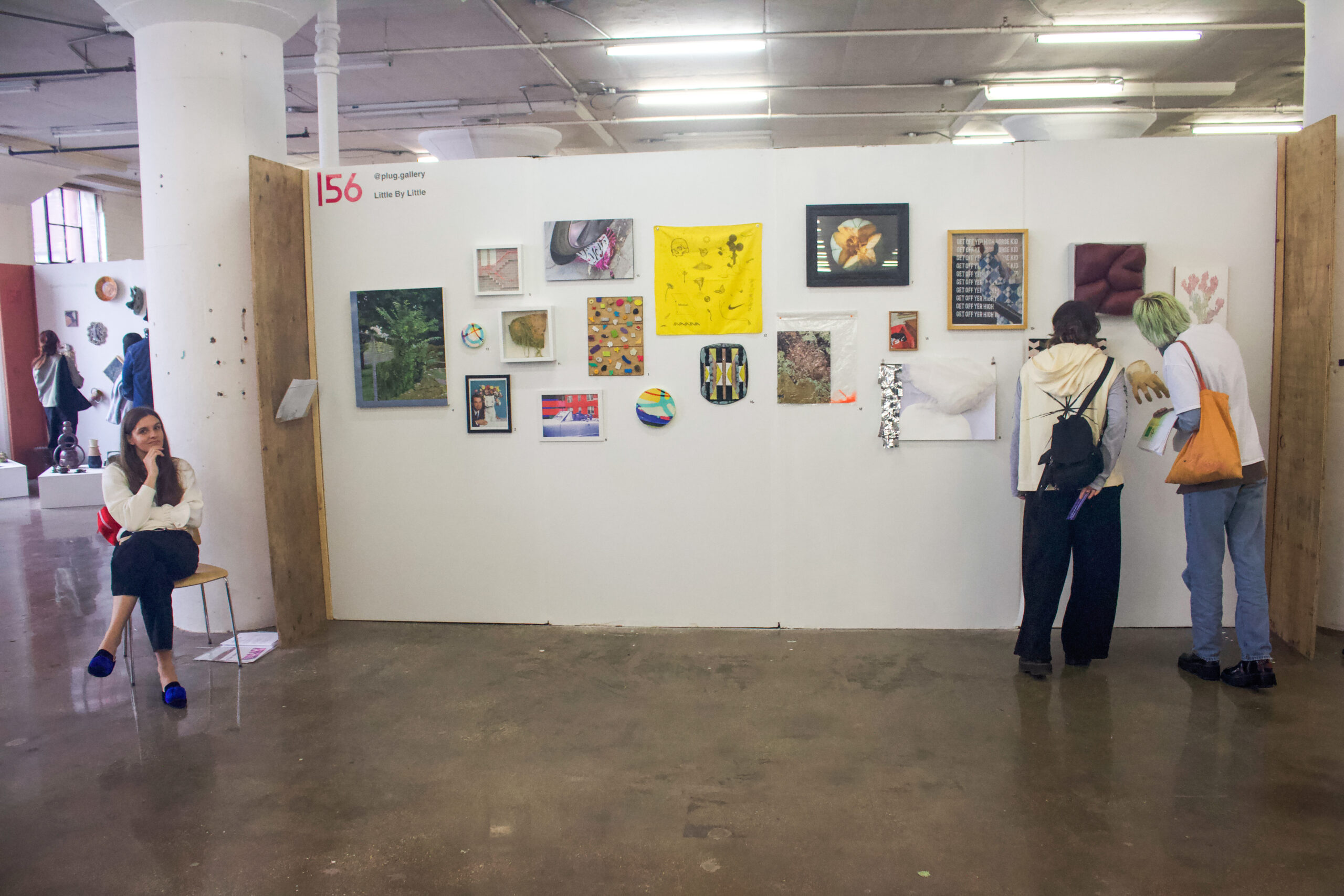
The interpersonal relationships with artists formed during the countless Midwest road trips. On an early trek to Kansas in February 2022, Alvendia reached out to Curiouser & Curiouser, an active DIY space in Kansas City, where he met with artists Samantha Haan and Cesar Lopez. Haan and Lopez curate exhibitions for Curiouser, and each has a robust artistic practice on their own. Additionally, they serve on the curatorial board of PLUG, another artist-run space that participated in MdW for the 2012 edition. They were already aware of MdW from archiving the history of PLUG. When speaking to Haan and Lopez in a recent interview, they expressed that they had an interest in participating in an art fair and the opportunity of MdW was accessible. Most established art fairs require a booth fee, along with the steep costs of travel, art shipping, and accommodations; in contrast, MdW Assembly was free to participate, and Charlotte Street Foundation provided a travel stipend for the participating Kansas City spaces.
Described as an alternative (to an) art fair, MdW’s overarching goal was “bringing together multiple hyperlocal scenes from across the Midwest” and to “facilitate opportunities to work together to build pathways for lasting coalitions of purposeful, artist-led action.” Haan and Lopez spoke about what makes MdW different from the traditional model of an art fair. Lopez noted succinctly that it “puts the vision of the artist first.” For instance, he mentioned a standout booth as the Chicago-based Mayfield space. Artist Maria Burundarena wrapped the entirety of the installation area and furniture, using reflective emergency blankets. Organizers Alberto Aguilar and Madeleine Aguilar supported and facilitated the vision of the artist for their space. In contrast, for a mainstream art fair, the gallery’s point of view is often prominent, given the financial investment in the booth fee and intention to sell artworks.
Another key facet of MdW’s alternative model is its sustained engagement over time. In a podcast interview with Bad at Sports, Alvendia articulates the way that MdW subverts the conventional art fair model, which usually takes place over one weekend as a spectacle; visitors fly in internationally and descend upon the art fair as a surge of social interactions, commerce, and parties. For MdW, he describes the “attempt to draw it out over a few months with the Atlas and the Drifts” using a multi-layered approach.


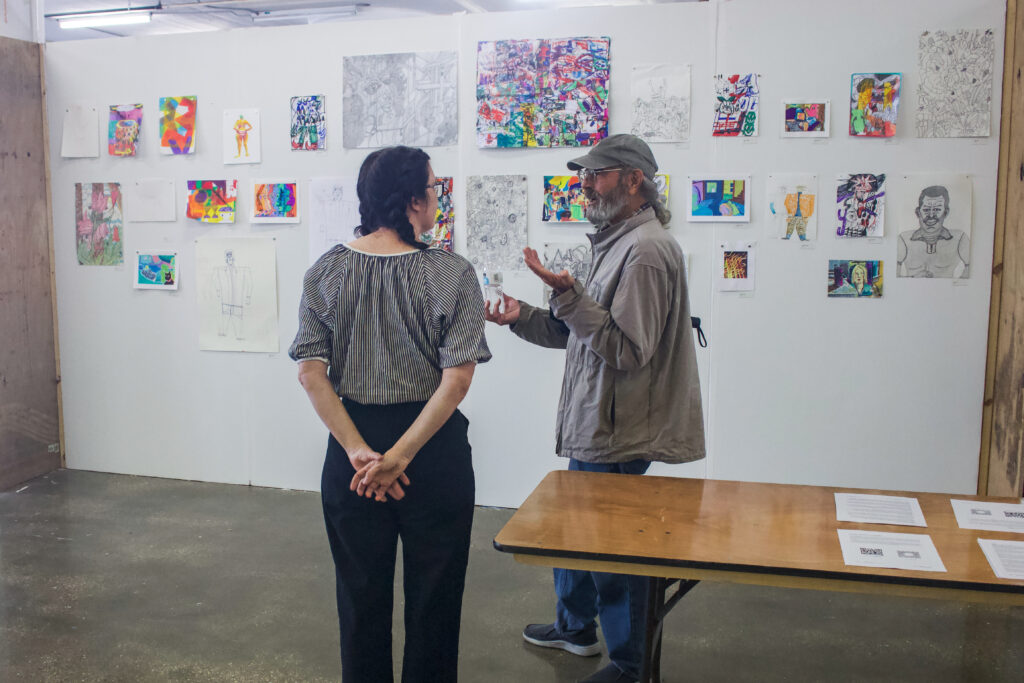

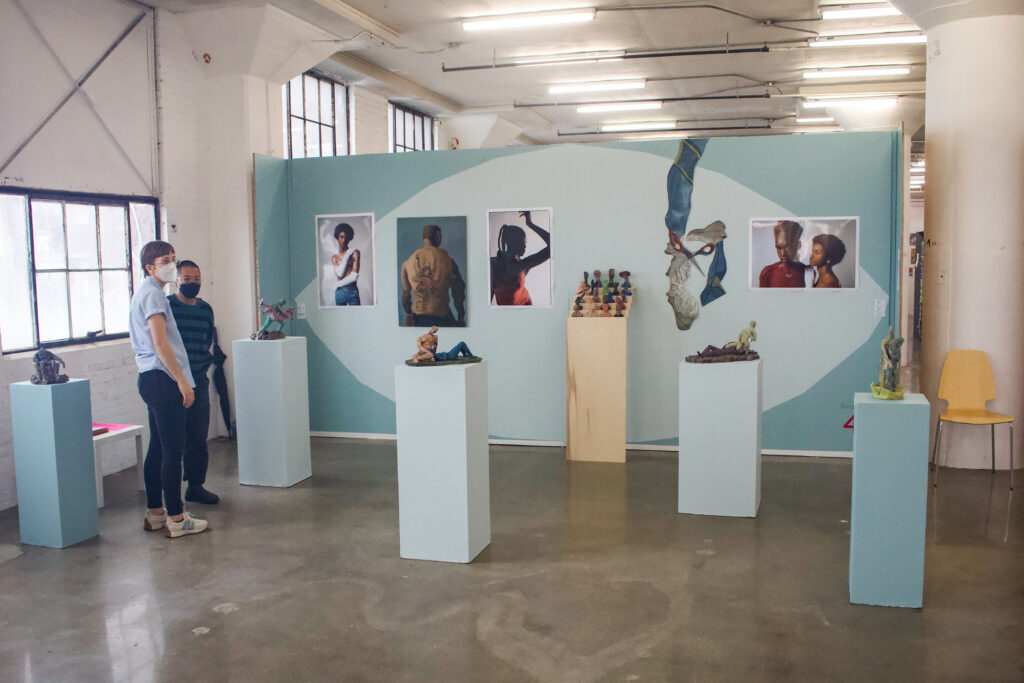
The MdW Atlas functioned as an online publishing platform, where each state partner chose an editor and contributing writers to post daily over two months. The MdW Drifts served as road trip itineraries with an interactive, crowd-sourced map to explore the cultural landscapes of the central Midwest. Instead of the frantic pace of an art fair crammed into a weekend, the multiple access points for MdW initiatives necessitate a longer span of time and attention from the participants. This sustained notion of time also mirrors the way in which Alvendia was building relationships over time, meeting people one by one and reinforcing meaningful, long-term connections.
Artist and curator Anna Wehrwein noticed this personal tone in the MdW Participant Guidebook. This sourcebook for the artists and organizers presented in-depth information on installation notes and other logistics. She mentioned that the written communications from MdW had a casual, affable tone. This detail, though seemingly insignificant, accentuates the person-to-person interactions and signifies the horizontal structure of MdW at large. Despite the varying scales, missions, and models for the artist-run spaces, the presentation of the booths implied a sense of equity.
Based in Columbia, Missouri, Wehrwein is the co-founder and director for stop-gap projects, an artist-run gallery and project space. stop-gap acts as the only artist-run space in the city of Columbia. Because of the relative isolation of running a contemporary art space in central Missouri, Wehrwein felt energized and excited after returning home from Chicago. As an arts organizer, she recalled that the most successful moments were “conversations… there were a lot of friend-to-friend moments that happened. The making of Kansas City friends was probably the most important thing that happened for us.”
In terms of Kansas City acquaintances, Wehrwein had discussed a potential collaboration with Cesar Lopez, prior to MdW. During the time in Chicago, they re-connected in person and then mounted a traveling exhibition called La Onda at stop-gap projects (December 2, 2022-January 6, 2023), featuring artists based in Kansas City and Columbia. The tapping into each other’s networks and creating a group exhibition together encapsulates the mission of MdW: facilitating ways to work together.

The shared organizing efforts between Columbia and Kansas City proved to be fertile ground for collaboration. While Kansas City has a density of artist-run spaces that have some mutual concerns, stop-gap projects operates in solitude. Wehrwein observed that “our role here being the beacon of experimental contemporary art…it’s important, but it’s lonely.” The gathering of urban and rural artist-run efforts at MdW aimed to coalesce these spaces. Wormfarm Institute, for example, operates in the rural context of Reedsburg, Wisconsin, whereas BULK Space exists in Detroit, the largest city in the state of Michigan. In a recent conversation with Alvendia, he articulated that the binary of the “urban-rural divide” is not entirely accurate, as there are so many nuances and the concept of urban to rural is a spectrum. The relationships between urban and rural communities are often complicated and fraught, especially considering the public ways that contemporary art projects manifest in these decentralized spaces. By bringing these spaces together, Alvendia expressed that the “hope is that these gulfs continue to be made smaller.”
Despite some variance in cultural contexts and geographic locations for the artist-run spaces, the MdW Assembly touched on a common value that drives the work of these artist organizers. Artist Samantha Haan spoke about the “willingness to work hard.”8 The organizers of these DIY spaces have a constant hustle of part-time jobs, side projects, as well as balancing an artistic practice, and sometimes parenthood. All of these pressures are met with a sincere effort to make things happen. At first, when Brandon Alvendia and Nick Wylie envisioned an assembly of artist-run spaces across seven Midwestern states, it seemed like a Herculean task. Nevertheless, with frequent Zoom meetings, local partners, and a shared vision, the larger connectivity of all these organizers became a reality.
After several years of exhibition-making and ambitious projects, the key often comes down to something simple: trusting your instincts and experiences, and letting the vision of the artist guide the way.
To republish this article for free, visit the ‘Republish Our Stories‘ page and contact our Managing Editor, Angela Zonunpari.
